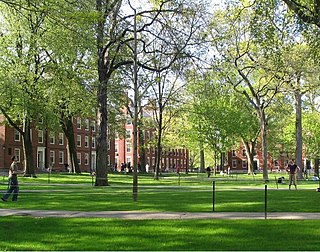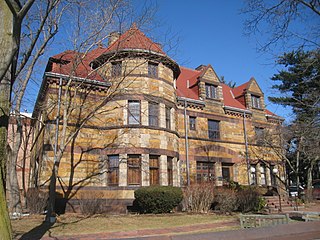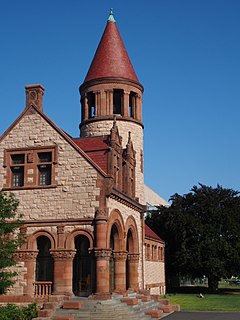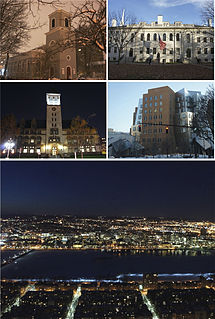
Harvard Yard, in Cambridge, Massachusetts, is the oldest part of the Harvard University campus, its historic center and modern crossroads. It contains most of the freshman dormitories, Harvard's most important libraries, Memorial Church, several classroom and departmental buildings, and the offices of senior University officials including the President of Harvard University.
Porter Square is a neighborhood in Cambridge and Somerville, Massachusetts in the USA, located around the intersection of Massachusetts Avenue and Somerville Avenue, between Harvard and Davis Squares. The Porter Square station serves both the MBTA Red Line and the Commuter Rail Fitchburg Line. A major part of the Lesley University campus is located within the Porter Square area.

Longy School of Music of Bard College is a private music school in Cambridge, Massachusetts. Founded in 1915 as the Longy School of Music, it was one of the four independent degree-granting music schools in the Boston region along with the New England Conservatory, Berklee College of Music, and Boston Conservatory. In 2012, the institution merged with Bard College to become Longy School of Music of Bard College. As of the 2017–18 academic year, the conservatory has 300 students in its degree programs from 35 states and 23 countries.

Peabody & Stearns was a premier architectural firm in the Eastern United States in the late 19th century and early 20th century. Based in Boston, Massachusetts, the firm consisted of Robert Swain Peabody (1845–1917) and John Goddard Stearns, Jr. (1843–1917). The firm worked on in a variety of designs but is closely associated with shingle style.

The Longfellow House–Washington's Headquarters National Historic Site is a historic site located at 105 Brattle Street in Cambridge, Massachusetts. It was the home of noted American poet Henry Wadsworth Longfellow for almost 50 years, and it had previously served as the headquarters of General George Washington (1775-76).

The Christian Science Center is a 14.5-acre (5.9 ha) site on the corner of Massachusetts Avenue and Huntington Avenue in the Fenway neighborhood of Boston, Massachusetts. A popular tourist attraction, the center is owned by the Church of Christ, Scientist, which refers to it as Christian Science Plaza. The complex, including most of the landscape was designated as a Boston Landmark by the Boston Landmarks Commission in 2011.

Alexander Wadsworth Longfellow Jr. was an American architect and nephew of poet Henry Wadsworth Longfellow.

Longfellow is a defined community in Minneapolis, Minnesota which includes five smaller neighborhoods inside of it: Cooper, Hiawatha, Howe, Seward, and Longfellow. Grouped with South Minneapolis between the city's eastern border with the Mississippi River and the Metro Blue Line, Longfellow takes its name from Longfellow neighborhood which in turn is named after Henry Wadsworth Longfellow. The renowned American poet incorporated elements into his poem The Song of Hiawatha from Henry Schoolcraft's accounts of native Dakota lore in Minnesota which included Minnehaha Falls in Longfellow's southern tip. The early reference of Highway 55 as Hiawatha Avenue, along the west border, may have influenced the naming decision when community borders were drawn in the 1960s. Hiawatha Avenue is the main thoroughfare leading north into Downtown Minneapolis and south to the Minneapolis-Saint Paul Airport.
Margaret Henderson Floyd was Professor of Architectural History at Tufts University. She was an expert on Boston architecture. Her writing includes several titles on the work of late 19th-century American architects including Henry Hobson Richardson, and Longfellow, Alden and Harlow.

Charles Street is the name of a north-south street in the city center of Boston, Massachusetts. It begins in the north at Leverett Circle, where it connects with Nashua Street and Monsignor O'Brien Highway. Science Park station on the MBTA Green Line is located there. Charles Street runs south and gives its name to the Charles/MGH station on the MBTA Red Line, connecting via the Charles Circle rotary to Cambridge Street and the Longfellow Bridge which leads to Cambridge. This segment is a one-way street, with traffic heading northwards.

The Masonic Building, located at 296 to 304 Walnut Street and 456 to 460 Newtonville Avenue in the village of Newtonville, in Newton, Massachusetts in the United States, is a historic building built in 1896 as a Masonic Lodge hall. It is a massive four-story redbrick Renaissance-style building with a turret on the corner and a steep slate pyramid roof. The upper floors are still used for meetings of Masonic lodges and appendant orders, while the lower floors are used for retail and office purposes. The building was approved for listing on the National Register of Historic Places in 1986, but due to owner objection it was not listed. However, it was included as a contributing property to the Newtonville Historic District when that district was expanded in 1990.

The Edwin Abbot House, also known as the Zabriskie House, is an historic house at 1 Follen Street in Cambridge, Massachusetts. Built in 1889 to a design by Longfellow, Alden & Harlow, it is a prominent local example of residential Richardsonian Romanesque architecture. It has served as the principal building of the Longy School since 1937. It was listed on the National Register of Historic Places in 1979, and included in the Follen Street Historic District in 1986.

Brattle Hall is a historic building at 40 Brattle Street in Harvard Square, Cambridge, Massachusetts. The Colonial Revival building was constructed in 1889 for the Cambridge Social Union to a design by Longfellow, Alden & Harlow. The Union was established as a social club in 1871, and moved into the adjacent William Brattle House in 1889. The hall was built to house the organization's library, and to provide a space for larger meetings and social functions. Original Dutch Colonial in character, the building acquired more of a Colonial Revival styling with the addition in 1907 of the brick ends, as designed by architect Charles Cogswell.

The Cambridge Public Library in Cambridge, Massachusetts is part of the Minuteman Library Network. It consists of a main library and six branches, located throughout the city.

The J.A. Noyes House is an historic house at 1 Highland Street in Cambridge, Massachusetts. It is a three-story wood frame structure, five bays wide with a gambrel roof and clapboard siding. The second floor hangs slightly over the first floor in a reminder of the early colonial garrison style. The main entrance is flanked by short sidelight windows and topped by a narrow semi-oval fanlight. A rounded bay projects to the left of the entrance, and gabled dormers pierce the roof. The house was built in 1894 to design by Longfellow, Alden & Harlow and is a well-kept example of Colonial Revival architecture; the yard was originally landscaped by Charles Eliot. The house is significant in part for the survival of its construction documentation.

Tory Row is the nickname historically given by some to the part of Brattle Street in Cambridge, Massachusetts where many Loyalists had mansions at the time of the American Revolutionary War, and given by others to seven Colonial mansions along Brattle Street. Its historic buildings from the 18th century include the William Brattle House and the Longfellow House–Washington's Headquarters National Historic Site. Samuel Atkins Eliot, writing in 1913 of the seven Colonial mansions making up Tory Row, called the area "not only one of the most beautiful but also one of the most historic streets in America."

Brattle Street in Cambridge, Massachusetts, called the "King's Highway" or "Tory Row" before the American Revolutionary War, is the site of many buildings of historic interest, including the modernist glass-and-concrete building that housed the Design Research store, and a Georgian mansion where George Washington and Henry Wadsworth Longfellow both lived Samuel Atkins Eliot, writing in 1913 about the seven Colonial mansions of Brattle Street's "Tory Row," called the area "not only one of the most beautiful but also one of the most historic streets in America." "As a fashionable address it is doubtful if any other residential street in this country has enjoyed such long and uninterrupted prestige."





















